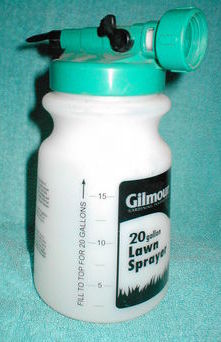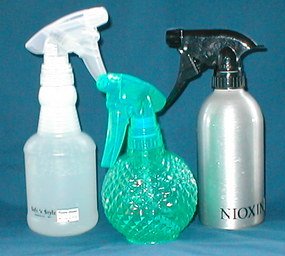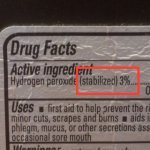Peroxide Gardening: Ways to use Hydrogen Peroxide in the Garden
The benefits of hydrogen peroxide for a garden can apply for any kind of a garden, and any method of gardening. Peroxide is great for plants that are planted in the ground, and it’s also great for plants in containers -- it is useful in hydroponic gardens, raised beds, and greenhouses.
Similarly, peroxide for gardening applies well with all kinds of plants: a rose garden, herb garden, vegetable garden, orchard, shade trees, flower garden or lawn -- any or all of these would benefit from hydrogen peroxide.
Peroxide works by releasing oxygen. It acts as an oxygen supplement for plants. It seems to really support both good health and strong growth for plants.
Hydrogen peroxide can also help with soil fungus: it aerates the soil, and it is anti-fungal. (It is also anti-bacterial.)
Ways to use peroxide in the garden
- General fertilizer, either in plant water or sprayed on foliage. This page has much more detail about how to mix and apply peroxide in the garden.
- For sick plants. Spray on the leaves and add to water.
- Hydroponic gardening. Hydroponic gardeners often use peroxide to feed plants, by adding it to the watering system.
- Spray on tree cuts, to prevent infection.
- As a spray in the greenhouse, to control mold and mildew.
- Sprouting seeds before planting. Added to the water that seeds soak in, the seeds will sprout faster and grow stronger.
- Rooting cuttings. Added to the water, if you’ve put the cuttings directly into water. Or, if you’ve put the cuttings into soil or medium, use peroxide in the water you’re using to water the cuttings with.
- Mold or fungus on plants or in the soil. Hydrogen peroxide will help to control mold on plants or in the soil. If you’ve got mold on the plant, spraying the leaves is probably best… This page has the story of my lemon tree with black mold on the leaves.
- Weed killer. I’ve never used it this way, and I’m not sure I would want to… but I’ve read that 10% hydrogen peroxide will kill weeds. Personally, I would rather pull the weeds up. If you do decide to try this, I certainly would NOT use 10% peroxide close to other plants… and I would come back later and add a LOT of water after the unwanted plants ("weeds") have died. This is very very very concentrated……
How much peroxide to use in the garden….
This page has charts showing the amount of hydrogen peroxide to use for watering and spraying plants, for general applications and for sick or fungsy plants. Please take a look – it only takes a little bit of peroxide.
Peroxide for sprouting seeds and rooting cuttings…
Here is a science fair project using hydrogen peroxide for sprouting seeds and rooting cuttings. In this experiment you can sprout seeds and root cuttings. Different amounts of hydrogen peroxide are used, and the results then compared.
Hydrogen peroxide in earth’s natural watering system (rain)
When the garden is watered by rain, there is a small amount of hydrogen peroxide in the water. It is part of the earth’s cleaning system.....
As rain comes through earth’s ozone layer, some of the molecules of water (H2O) pick up an additional oxygen atom (O), becoming H2O2 – hydrogen peroxide!
Oxygen is O2, while ozone is O3. Ozone is very unstable -that third oxygen atom moves on easily. So the water has no trouble picking up some single oxygen atoms.
Hydrogen peroxide is also very unstable -oxygen is readily freed up to oxidize various things that it encounters (such as bacteria, viruses, mold, pollution…) In the process of oxidation, the hydrogen peroxide (H2O2) is broken back down into water (H20) and oxygen (O).
Hydrogen peroxide will oxidize many kinds of pathogens and pollution, so it helps to clean the air, as the rain falls. I’ve read that there is currently less peroxide in rain water than was common in the past, since oxidizing air pollution now "uses up" much of the peroxide. (Hydrogen peroxide is always "used up" by the oxidation process.)
Now, I think that cleaning up some of the pollution in the air is a fine use for hydrogen peroxide, as the air after a rain is so much nicer to breathe. But our plants like peroxide too!
Additional pages about hydrogen peroxide in the garden:
How to mix and apply hydrogen peroxide in gardening
Return from hydrogen peroxide garden uses to the main page for the site....
Subscribe to Hydrogen Peroxide Explorers' Newsletter
Our newsletter will keep you up to date on new pages added, plus some Adventures you can try at home:
No worries! Your email will be used ONLY to send you newsletters.
(Gallon):
(5 pounds):
For some links, I receive ad commissions, at no cost to you. More info here.
Site Search:
Subscribe to our newsletter (free):
Note: Products shown are sold by Amazon. This site does NOT sell hydrogen peroxide.
Do you like this site?

Gardening: attach sprayer to garden hose; use to dilute peroxide and spray on the garden

Spray bottles for peroxide




